If there is one thing most people know about SEO, it’s that keywords are important. It was true from the beginning and is still true today.
However, many brands don’t have an SEO keyword strategy or even know they need one. It’s much more than just adding keywords to your pages. It’s discovering the right keywords in the first place and then understanding what content is needed to target each keyword.
While SEO encompasses a lot more, we’ll focus on keywords for this article: how to discover, target and rank for effective keywords that are common in the food and beverage industry.
We’ll cover:
- What is keyword research?
- What keywords and topics to target?
- What keywords may be surprisingly difficult to rank for?
- What types of content are needed to rank for those keywords?
- What are the top opportunities, nuances, and pitfalls of food SEO keyword research?
Keyword Research 101 for Food and Beverage
We have a lot of interesting food-specific SEO tips coming up but let’s first start with a primer on keyword research.
What is keyword research?
We define keyword research as discovering and prioritizing keywords to target through analysis of search data and ranking content.
Keyword Research uncovers the most relevant keywords that your potential customers (not you or me) would type in a search that could lead to your information about your product, company, or content. It then identifies which of those keywords is most attractive to target. Keywords research then feeds into content strategy, which determines what content is needed to effectively target those keywords.
For example:
- Should you describe your product as ‘vegan’ or ‘plant-based’? Vegan is searched more but also more competitive while plant-based is less searched and less competitive.
- Is ‘gluten-free snacks’ too competitive to target with your product page? If so, what content could give you the best chance? Or what is an alternative keyword to target?
Keyword research begins with a starter list of usually 10-20 keywords. We then expand this starter list into a much larger list of (usually) thousands of related keywords using several keyword databases. Then we prioritize the best keywords from the massive list using various methods to arrive at the vital few to target.
The main three prioritization criteria for keyword research are:
- Keyword volume
- Keyword difficulty
- Search Intent
Keyword volume is the number of times a keyword is searched monthly in Google or other search engines. The more common the keyword the more it will be searched.
Keyword difficulty is a metric (usually from 1 to 100) that SEO tools provide as a measure of the SEO competitiveness of a keyword or phrase. These data are fine for a first pass but, in my opinion, truly understanding the difficulty level of a keyword you may target requires human analysis.
Note: There are other data you can potentially factor in like CTR (expected click-through rate) and seasonality trends but we will not cover these secondary metrics in this article for the sake of simplicity.
Ah, now Search Intent.
After a keyword passes the first filters of acceptable volume and difficulty, you should manually look through search results and ranking pages to get a qualitative perspective of the situation. Consider the following: What type of content is ranking, who are your search competitors, how well do the search results align with the search query, can your brand create the content that is needed to compete, etc. The answers to these types of questions provide the insights and learnings crucial to creating your SEO and content strategy.
Keyword Research is the most laborious and time-consuming part of SEO in my opinion. But it’s also where many valuable industry-specific and company-specific nuggets surface. Most food brands don’t do this analysis or may not even know it needs to be done. You can get a leg up on the competition by putting in the work (or hiring us to do so).
Tip: Don’t let competitive difficulty stop you from creating content
Even if your research shows a keyword doesn’t have a good shot of ranking in search, it never hurts to create new content or tactfully include a new relevant keyword. There may be other uses of that page for your website visitors who may find you from other sources. You might rank for a longer-tail keyword even if the main head term is too difficult. Also, visitors might find you through another page from search but make their way over to the new page that doesn’t rank so well but is valuable. The point is just because a keyword isn’t a good SEO target doesn’t mean you should not include it on your website.
Keywords your brand should consider targeting
With food and beverage SEO projects, some common keyword trends surface time and time again across companies and food categories. Your brand should be ranking for many if not all of these keywords and topics as part of its SEO.
Common keywords food and beverage companies rank for:
- Branded words: company name and product name
Example: ‘Lightlife’, ‘Spindrift’, ‘Justins Butter’
Many food brands rank for their company name, brand name, and product name. For most brands, these will be the easiest keywords to rank for. As long as your company name is not super generic, you should be able to rank for your company name with basic SEO. If you do have a generic name or are finding it hard to rank for branded words, more advanced tactics are in order. While the topic of how to optimize is another article for another day, you can start by simply adding the brand keywords throughout your site in relevant places.
- Product category (non-branded)
Example: ‘Greek yogurt’, ‘Pesto’, ‘Tzatziki sauce’
The general name for your product category will likely be a lot tougher to rank well for. Potentially orders of magnitude more difficult. Why? Because now there are many in the running to rank. And it’s probably not just food brands. There could be food blogs, medical sites, recipe sites, Wikipedia, media publications, and more in the mix. However, the rewards are greater when you do rank because success here means many new customers that probably didn’t know of you discovering your brand (for free).
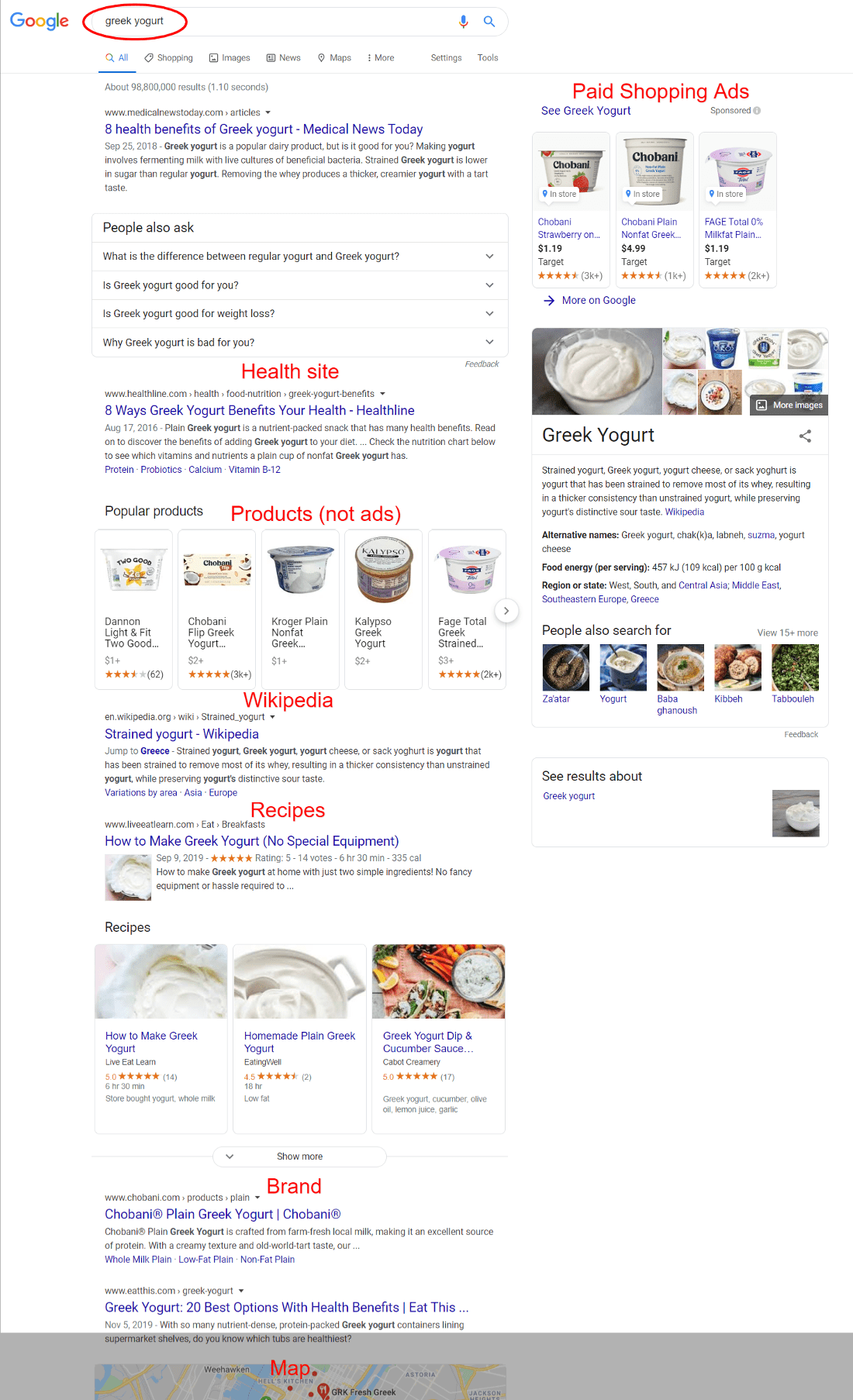
The key to ranking for these keywords is to match the search intent (that is, match the type of content that Google is displaying on the front page). Now, you may not have the type of content Google is showing (whether a recipe or blog post). In that case, your homepage or product page likely won’t rank. Instead, create the content Google is showing or risk search irrelevance. For more, check out the related tip, Google it.
Tip: Google it
Sounds obvious but many overlook this step. When choosing a target keyword to create content around, Google it. Look through search results of your target keyword to survey the situation. You are going to want to know what sites are ranking, what content types are ranking, how well the results address the actual search query, are there a lot of ads or quick answer boxes, etc. This is figuring out the search intent. You are going to want to try to rank with content that is of a similar type but higher quality than currently ranking content.
- Where to buy + brand/product
Example: ‘Where to buy chickpea pasta’ or ‘Where to buy Halo Top’
People will be searching ‘where to buy XYZ’ with XYZ being either your product name or the product category. You typically want to optimize your store locator page for these queries. Again, optimization is a whole topic unto itself but start with incorporating keywords in relevant, non-spammy ways.
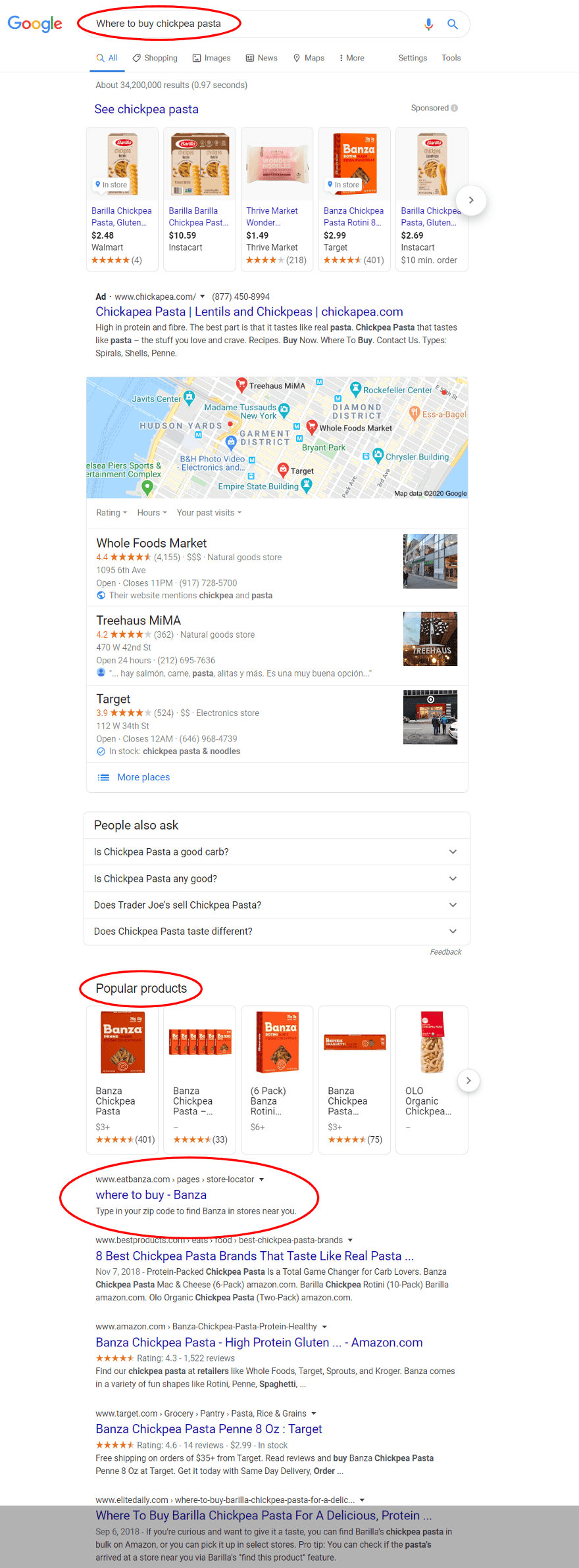
One missed opportunity we see with many food brands with e-commerce presence fail is not mentioning on their ‘Where to Buy’ page that online is an option (whether their e-commerce store, Amazon, or a third party like Thrive Market). Many sites only put retail locations or a retail store widget on this page.
- Store name + brand/product
Example: ‘Greek yogurt walmart,’ ‘Whole foods Chobani’
People want to know if the store they shop at carries your product or the product category. The pattern people search is something along the lines of: {store name + either your brand/product category}. If you aren’t ranking with an existing page, the first option would be to optimize your store locator page for these queries by adding store names and logos on the page (outside of the store locator widget).
Alternatively, sometimes a simple press release or blog post announcing entry into a new store will do the trick.
- Brand/Company + Reviews
Example: ‘Siggi’s reviews’
One of the few times you might actually want to hear opinionated people online is when you are researching a product and want to hear from those who have tried it before. Yes, people do search for reviews of food products before buying. Data shows that often one of the most common searches related to food brands is {food brand + reviews}.
A common mistake is most brands don’t own the pages or videos that surface for these. Although, SEO-savvy brands know having a reviews page on their site will likely rank well and allow them to control this query to a certain extent. The reviews page can be a smattering of reviews you have received. Without one, you could be at the mercy of some random person who uploaded a quick cell phone video to Youtube. And…these videos often do rank well as video carousels show prominently in many review search results (and even sometimes for searches of the overall brand name). Another option to get ahead of this is to sponsor a video by an influencer to post to YouTube. It’d be weird to review your own product but you can always highlight (or sponsor) others.
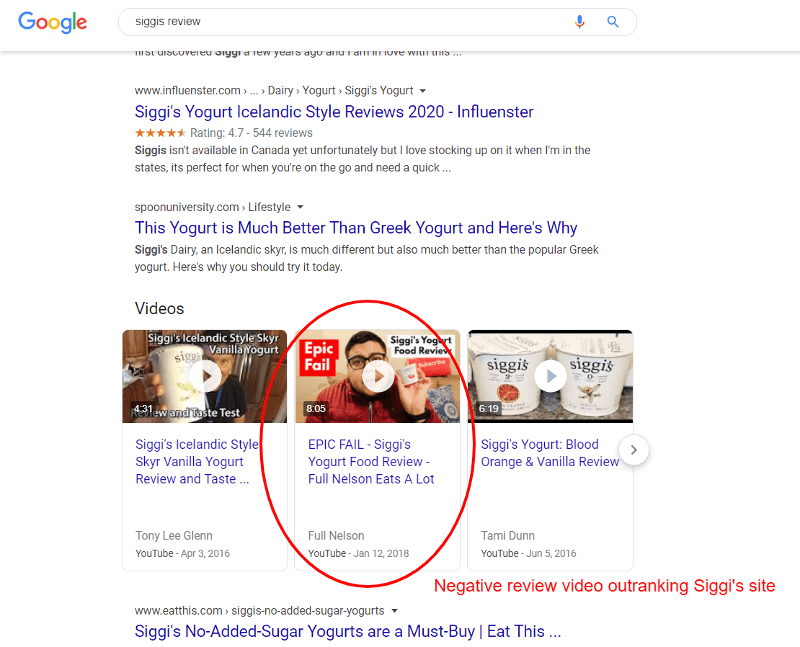
- Ways to Use + product
Example: ‘Ways to use horseradish, ‘Ways to use freekeh’, ‘Ways to use miso paste’
For certain types of foods, people are searching for inspiration or novel ways to use that product. If your food is a type where people are looking for ways to incorporate it into their diets and meals, then consider creating a Ways to Use page. While this page can include recipes it’s more than just that. It can cover the food’s uses as an entree, side dish, holiday staple, ingredient in another dish, different cooking methods, etc. It could be a blog post or a regular page if you don’t have a blog.
Here is a ‘ways to use’ blog post from Kettle & Fire that is ranking front page (search results follow):
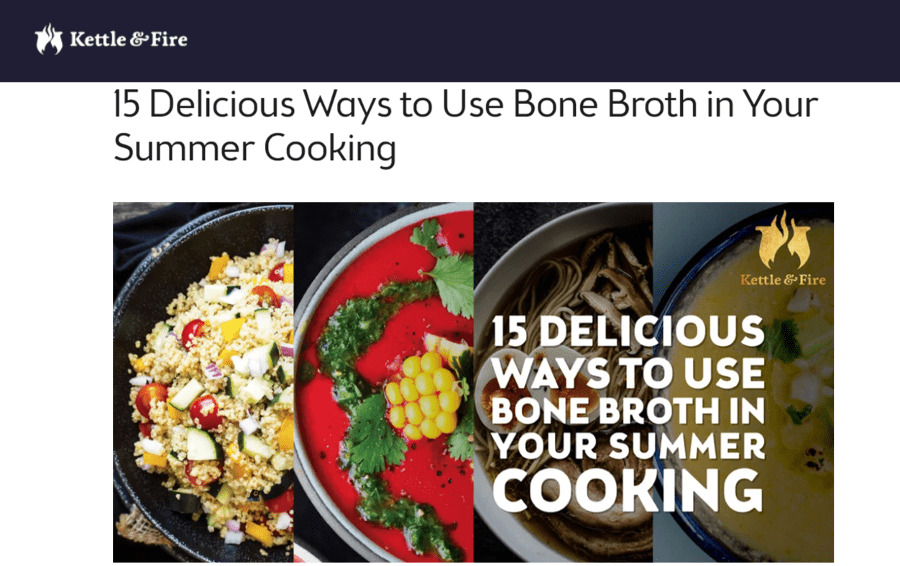
To find out if your food type is one that people are looking for inspiration with, you can use an SEO keyword tool such as Google Keyword Planner, Keywords Everywhere, SEMrush, or Ahrefs to name a few.
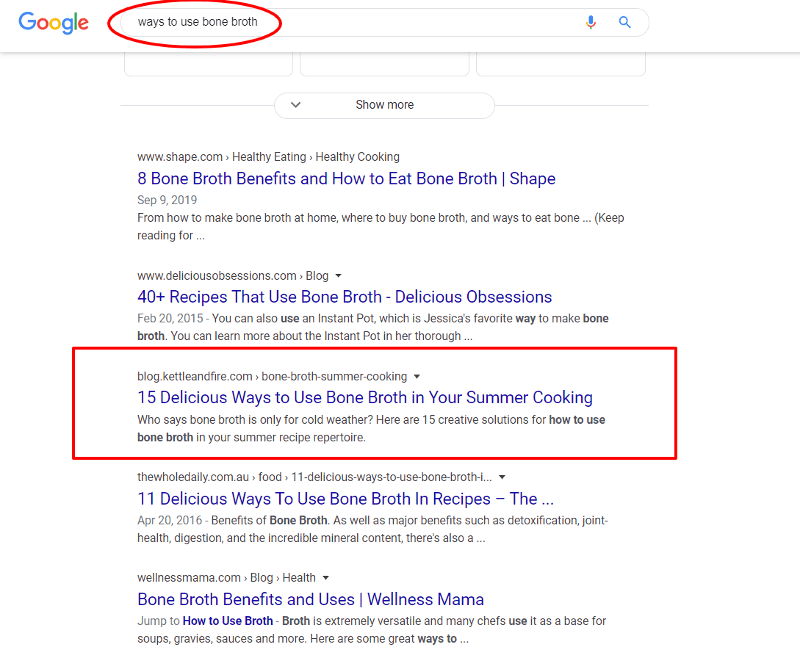
Also, some folks might be searching for Ways to Use + brand name of product, but that is likely less common.
- Main Ingredients of your product
Examples: ‘Jackfruit’, ‘Aquafaba’, ‘Cassava’
Many emerging food brands are made of ingredients that we didn’t see, eat, or know growing up. One of the first things people look up about a product is the ingredients. If there is one that people don’t know, they will get intrigued and search for it. Or maybe they came across a story online or on TV about an up and coming superfood. Whatever led to the search, people want to know about the interesting ingredients in their food. To rank for these keywords, your best bet is to create a comprehensive blog post or guide on the main ingredient that is mostly educational.
- Names of Founders, CEO, or other key employees
Examples: ‘Mark Sisson, ‘Kara Goldin’, ‘John Sorial’
This may not be a very commercial keyword category but ranking for your founder or other employees name could bring website traffic and thus brand awareness.
Valuable food keywords that may be difficult
We are not saying you shouldn’t create content or try to rank for these but they may be more difficult than you anticipate (or even too difficult in certain situations) to invest in content and get results.
- Benefits of Product Category
Example: ‘benefits of kombucha’, ‘benefits of green tea’
So your product has some interesting health-related benefits. You know content is important so you want to create some content around it. While the content will be valuable to have, it may be difficult to rank for your main target keyword of ‘benefits of xyz’
Why? Because many authoritative health-information articles are potentially dominating the search results.
So definitely look through search results first. Some of these health benefit searches are loaded with high authority sites like Wikipedia, Mayo Clinic, Healthline, and Harvard.edu. Also, health-related search results are held to a higher standard by Google so credibility is even more important than usual.
Say you are a maker of kombucha and would like to rank for ‘benefits of kombucha’ for example.
The front page of ‘benefits of kombucha’ features NY times, WebMD and Cleveland Clinic. So it won’t be easy. However, we do see that GT has content ranking at a respectable #8 on the front page. So they are certainly getting some valuable traffic from this keyword and longer-tail related keywords.
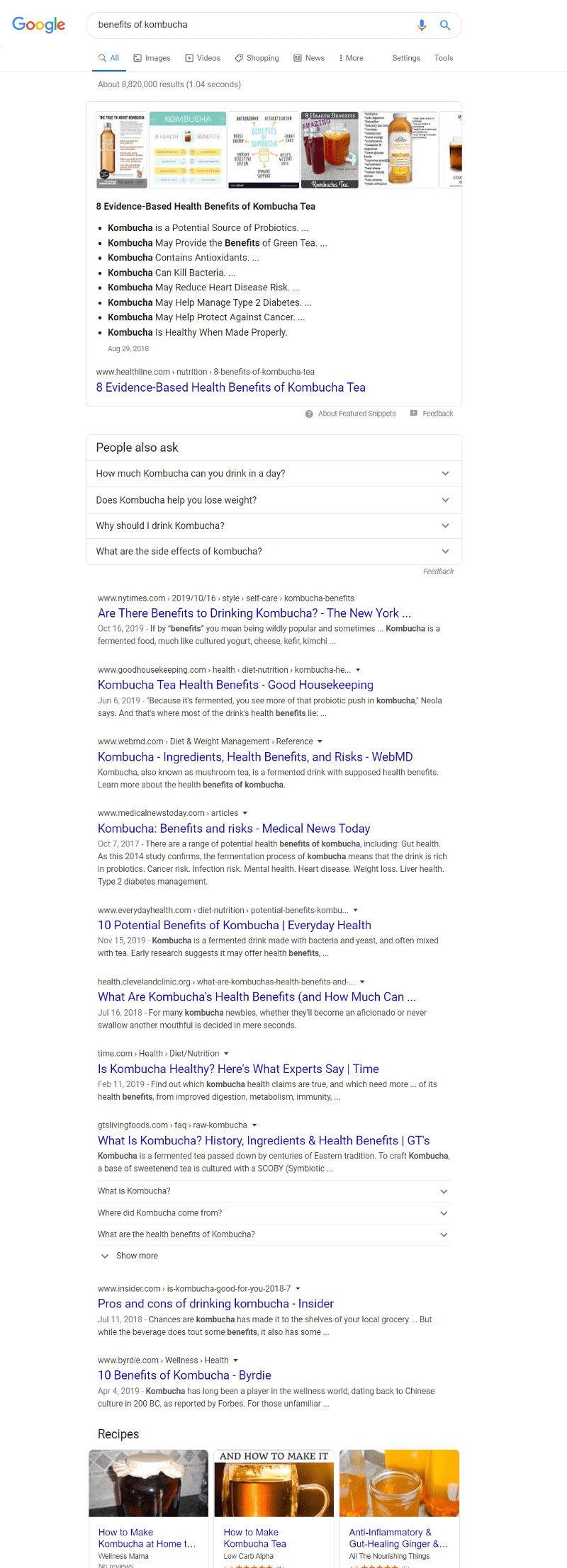
Now, seeing authoritatie sites is not necessarily a sign to not target that search term. Sometimes authoritative sites are shown in results but the page is not 100% addressing the intent of the search result. Other times, you can beat out higher-authority sites because you are an expert in a niche therefore actually higher authority on that topic. For example, sites that solely cover paleo food can outrank sites that are overall more authoritative for paleo-related keywords.
- Recipe keywords
Example: ‘Fish taco recipe’, ‘Sangria recipe’, ‘french toast recipe’
Food brand websites with recipes usually get traffic and rankings for at least a few of their top recipes. That said, I often see many recipes of food brands receiving little to no search engine traffic (however, they often are not optimized too so that is also partly to blame). Not getting a ton of search traffic to recipes could be fine because recipes are valuable content for other channels such as social media and email newsletters. But if you create them, you may as well put your best SEO foot forward to get the most visitors from Google you can.
Brands underestimate how hard it is to rank for recipes. Especially for common dishes. There are a ton of recipe sites, Mom blogs, food publications, media publications, and other sites that post recipe content. So to get to the top 10 for a popular recipe that is searched frequently is a competitive task. A more specific recipe could be easy to rank for but the search volume may not be high enough to justify the effort. But if done right, recipes can introduce new visitors to your brand. They probably won’t lead to a lot of purchases right there on the spot though.
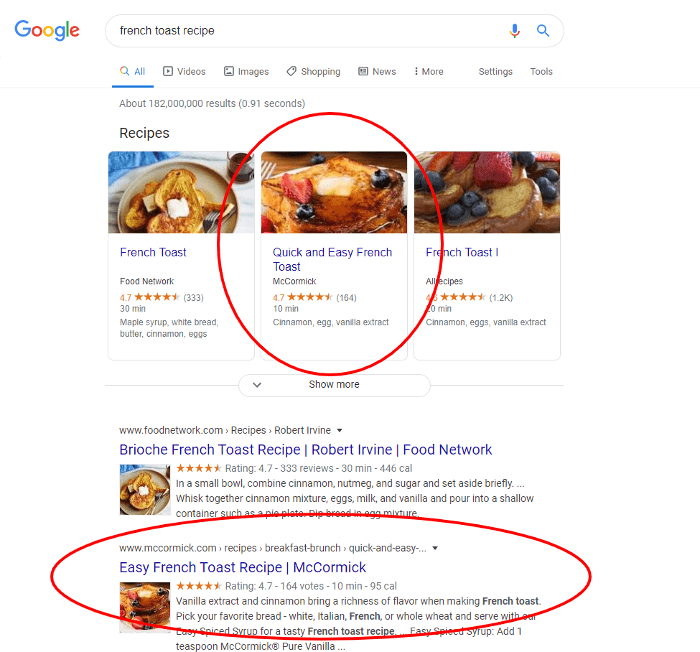
One tip is to use recipe schema markup. One of the most common missed opportunities is that food and beverage brand sites don’t have schema markup on the back end of the recipes. Schema markup is what shows recipe information like calories and cook time directly in search results. While it technically won’t raise your rankings according to Google, it should increase click through rates. You can use a plugin, extension or, if more advanced, you or a colleague could manually implement schema markup into the backend code of your site.
Lastly, it’s a bit of a hack but if you genuinely include the word ‘recipe’ on relevant pages of your food brand’s site (“inspired from a family recipe”) this may be enough to rank you on the front page for recipe searches without having a recipe!
- Dietary keywords + product category
Example: ‘Vegan snacks’, ‘gluten-free granola’
Are you trying to rank for a well-known food descriptor about your food category?
While the search volume of these keywords could be very attractive, the keyword difficulty could be surprisingly high. With these types of searches, there could be many different types of organizations vying for these keywords: health info sites like Healthline, medical sites like Mayo Clinic, prominent food bloggers, other food brands, well-known media publications. With only 10 spots on the front page (at most), many of these broad, one-modifier categories will be too difficult.
One strategy you could try is to stack two or more dietary descriptors. By descriptors, I mean descriptive modifying adjectives. So instead of ‘vegan snacks,’ maybe target ‘low sodium, vegan snacks.’ Also, keep close attention to what content is displaying. Often, these types of search results show lists of products may be content you don’t have (yet). Lastly, if you feel it’s too competitive for SEO, you can always try the PPC (paid search ads) route.
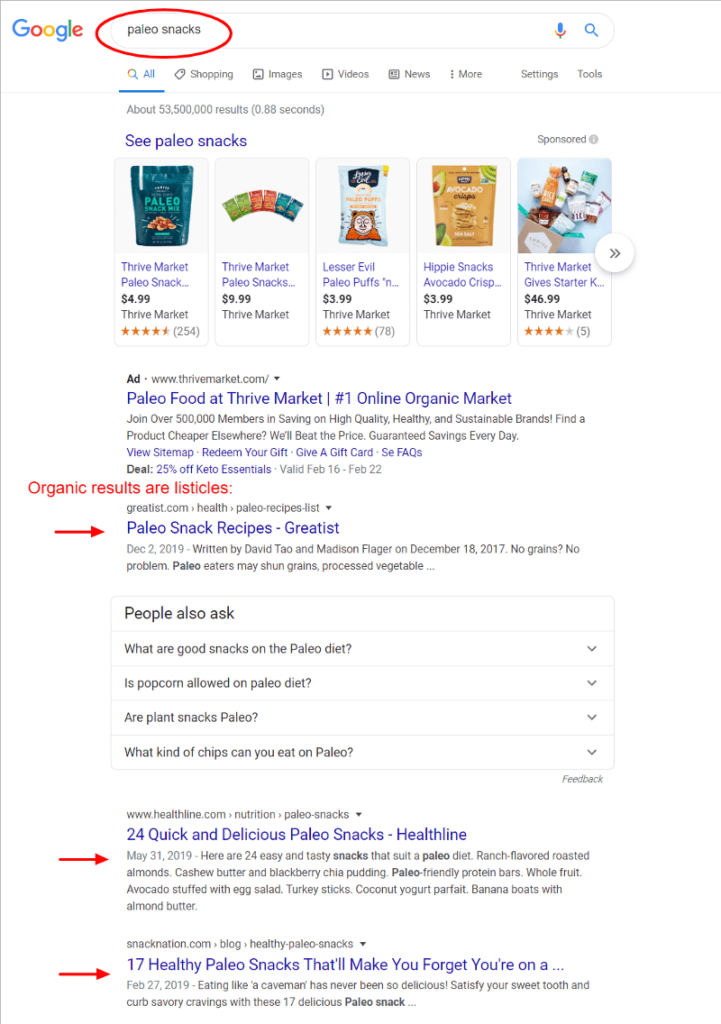
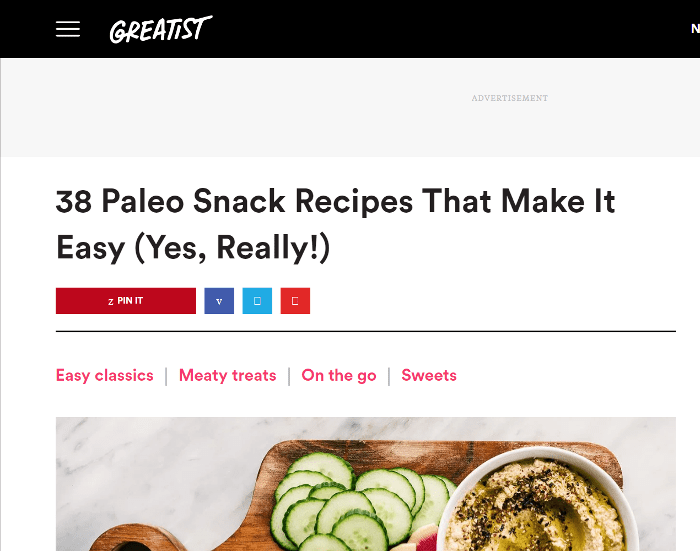
- Nutrition Facts of branded/non-branded food
Example: ‘Protein in Clif bar’, ‘How many calories in coconut oil’
People search for nutritional facts. Through keyword research, you might find out that a lot of people are searching nutritional facts about your product or category. So you may think that this would be an excellent SEO keyword target. Logical but be careful.
No click searches are on the rise because Google is showing more answers directly in the SERPs (Search Engine Results Pages). Especially with facts like nutrition, you may find that Google just provides that answer right in search without a need to visit your site with one of those quick answer information boxes. Even if there is not a quick answer, there may be one soon. And also, even if there is not a quick answer a site that focuses on nutritional data will typically surface.
This is a tough one to crack so I would not recommend targeting these types of keywords as a core part of your SEO strategy. That said, it still would help to have this information for readers, even if it’s unlikely they will find it through the main search term. So go ahead and include the information on your site as it will be helpful and there’s always a chance it may rank even if it’s only for a few longer-tail keywords.
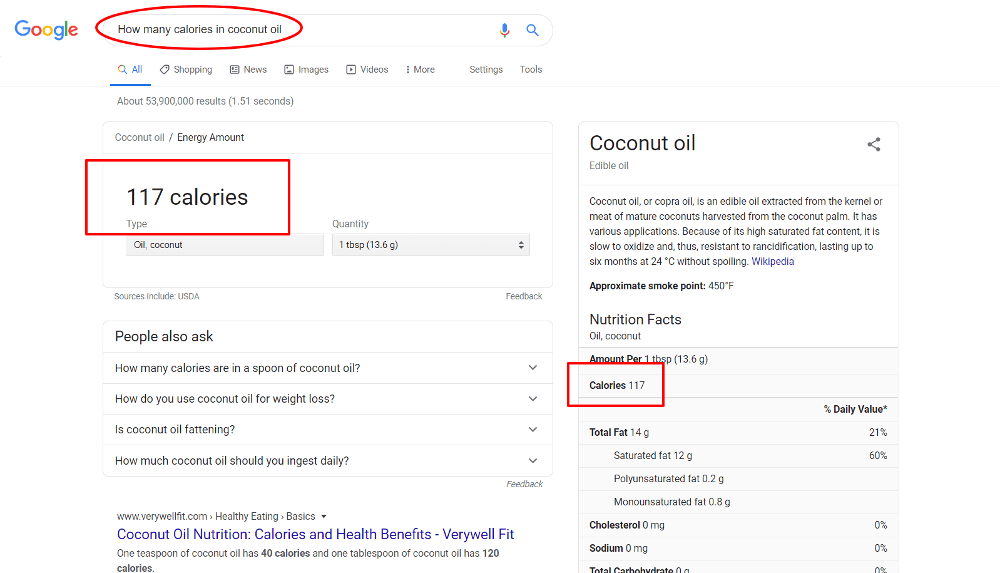
What’s next
While this article provides some good keyword topics and guidance, it’s not a replacement for keyword research. Every product category and competitive situation is different so conduct keyword research specifically for your brand. Reach out if you need help doing so.
Once you have the target list of keywords, you want to map those to which pages should target them. Then either optimize those existing pages with the new keywords or create new optimized content if needed. Don’t do keyword research for its own sake. If you don’t use it, it won’t benefit your brand.
/


